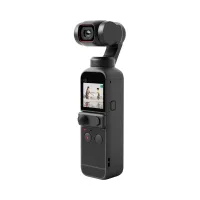TechRadar Verdict
Kudos to Canon for offering an alternative user experience to most other vlogging cameras – the Powershot V10 is purpose-built to make content creation as easy as possible. However, despite its refreshing design, the tech inside is both dated and limited, and there aren’t too many reasons to pick it over your smartphone unless you really want something different.
Pros
- +
Quirky, pocketable design with stand
- +
Well priced
- +
Clear in-camera audio recording
- +
Plug-and-play webcam
Cons
- -
Dated technology
- -
No optical stabilization
- -
Limited recording times
- -
Digital IS not always effective
Why you can trust TechRadar
Canon Powershot V10: Two-minute review
The Canon Powershot V10 is a first-generation camera, singular and simply designed for vlogging. It’s essentially what your smartphone can already do, and in 4K quality.
However, using it isn’t quite like the experience you get from a phone. This tiny camera has a design that I see becoming popular with younger users; a fold-out stand, a fixed lens, minimal control buttons and a tiny flip-up screen is all there is to it. It’s unlike anything else out there and, held upright, it’s smaller than my iPhone 13 Pro.
It offers 4K/30p and Full HD 60p video recording, plus the option to shoot 20MP stills captured in JPEG format. There’s not a lot of complicated menus to sift through here or too many video options to confuse the newbie. It really is meant for those who are intimidated by more dedicated vlogging cameras like those from Sony.
As nice as that may be, there’s some dated tech under the hood – namely the sensor. It’s the same 1-inch sensor from the Canon Powershot G7 X III from 2019. There’s no arguing that it produces excellent results, but it’s not the fastest sensor, so autofocus isn’t on the same level as Canon’s newer EOS R series of cameras. Perhaps that won’t matter too much to the Powershot V10’s target audience, but the fixed 18mm f/2.8 lens that can’t zoom, might.
The Sony ZV-1F is another vlogging camera with a similar fixed focal length lens, but with a different design it is less pocketable. The Powershot V10 on the other hand is such a tiny thing that you can pop it into your pocket and take it anywhere. It’s a great tool for travel vloggers, but then a fixed wide-angle lens is very limiting if you want close-ups of something you can’t zoom into.
Given that, it seems as though the Canon Powershot V10 is best used for vlogging when you’re up close and personal with the camera itself, thus limiting its use. Its price point, however, might work in its favor and its appeal to the younger generation and make this a popular camera.

Canon Powershot V10: release date and price
- $399 / £429 / AU$699 for the vlogging kit
- Advanced vlogging kit for Europe only costs £459
Announced in May 2023, the Canon Powershot V10 is now available to buy priced at $399 / £429 / AU$699. In the box for this price in some markets is a rubber lens cap made by SmallRig, and magnetic windshields for the stereo mics on the top of the camera.
Sign up for breaking news, reviews, opinion, top tech deals, and more.
In Europe only there’s also an Advanced Vlogging kit, which additionally includes a SmallRig cage priced at £459. We were told that this was the first time Canon had partnered with the accessories maker ahead of a product launch to produce compatible accessories.
Compared to other vlogging cameras on the market, particularly those from Sony, the price of the Powershot V10 seems reasonable enough. It’s cheaper in the US, where the Sony ZV-1F is $499. However, in other countries, like Australia, it’s about the same price as the ZV-1F at the time of writing.
And given how basic the Canon is, I’m not convinced there’s a lot of value for money here if you already have a flagship smartphone that can shoot good videos.
• Value score: 3/5
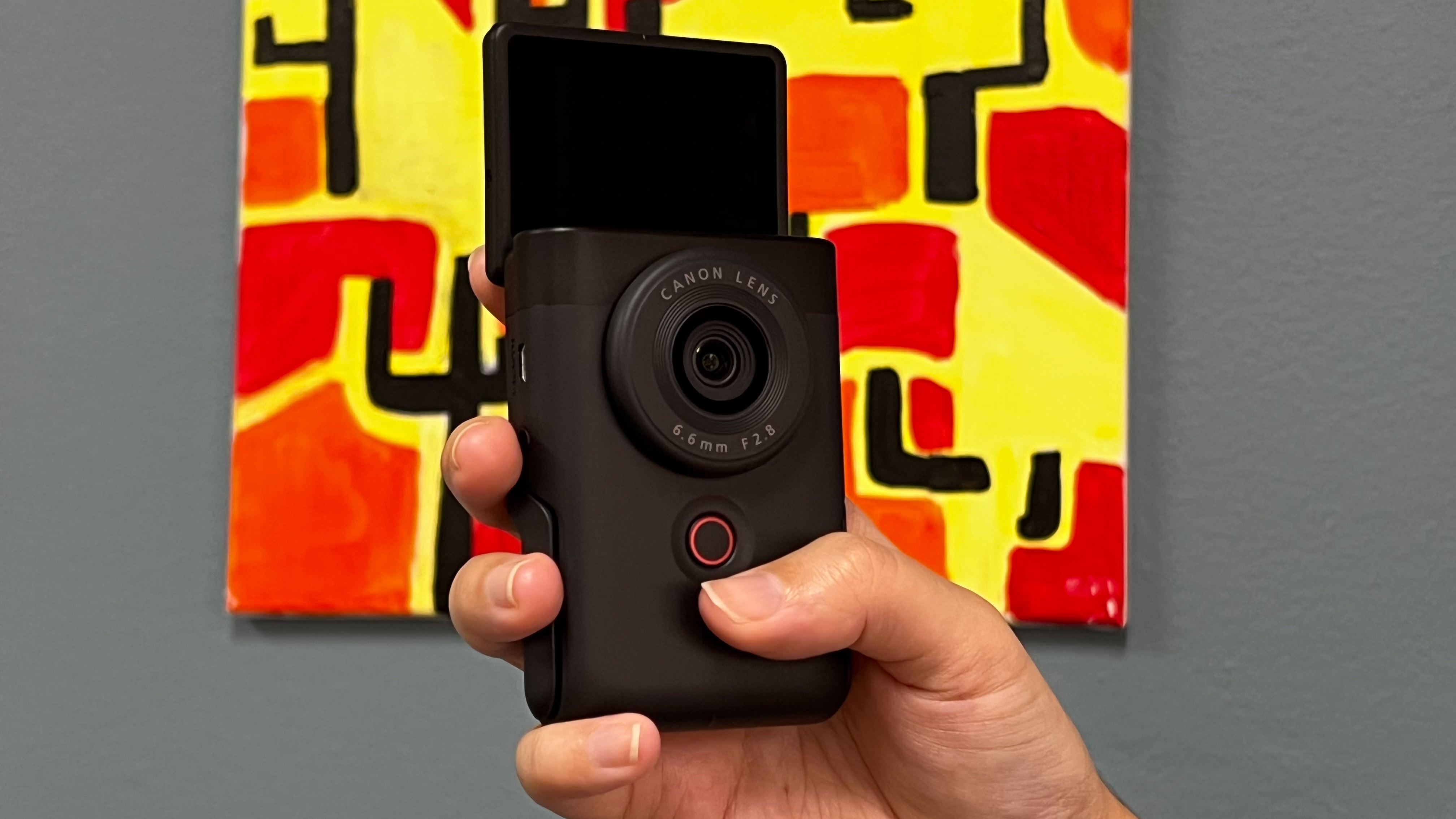
Canon Powershot V10: Specifications
| Sensor: | 20.1MP 1-inch BSI-CMOS |
| Video: | 4K/30p |
| Stills: | 15.2MP |
| Stabilization: | Digital IS |
| LCD: | 2-inch 180º tilting touchscreen |
| Memory cards: | 1x microSD |
| Connectivity: | Micro HDMI, 3.5mm mic input, USB-C, 2.4GHz Wi-Fi |
| Battery: | 1,250mAh |
| Dimensions (w x h x d): | 90 x 63.4 x 34.3 mm / 3.5 x 2.5 x 1.4 inch |
| Weight: | 210g / 7.4oz body only |
Canon Powershot V10: design
- Built-in fold-out stand means no tripod needed
- Simplified custom user interface
- Fixed 18mm ultra-wide lens
Nestled in the palm of my hand, the Canon Powershot V10 weighs in at mere 210g and offers a completely different user experience to most other vlogging cameras – for better and for worse.
To put its size into context, it’s half the size of my iPhone 13 Pro with the screen folded down and, even with the screen opened up, it stands shorter than the phone. It’s significantly chunkier, though, but that thickness offers a sense of security for something as small as the Powershot V10.
It’s certainly a curious camera. The first thing I’m drawn to is the flip-up 2-inch touchscreen, and tucked inside that a neat, built-in, fold-out stand. The stand is surprisingly sturdy, and I can already see how it removes the need to carry and set up tripods and other mounts, and makes life with a camera pointed at yourself that much easier.
Neither myself nor my colleague who collaborated on this review are content creators ourselves, but we know all too well the challenge of precariously balancing a phone for hands-free selfies (of course optional phone stands are available). Whether you’re recording yourself playing an instrument, or cooking, or doing whatever you want to share online hands-free, the V10 simplifies the process.
The display is in 3:2 aspect ratio – and that’s the aspect ratio the sensor uses for photography, but for 16:9 video recording there’s a black border on the top and bottom of the frame, which does give on-screen options a little room to breathe.





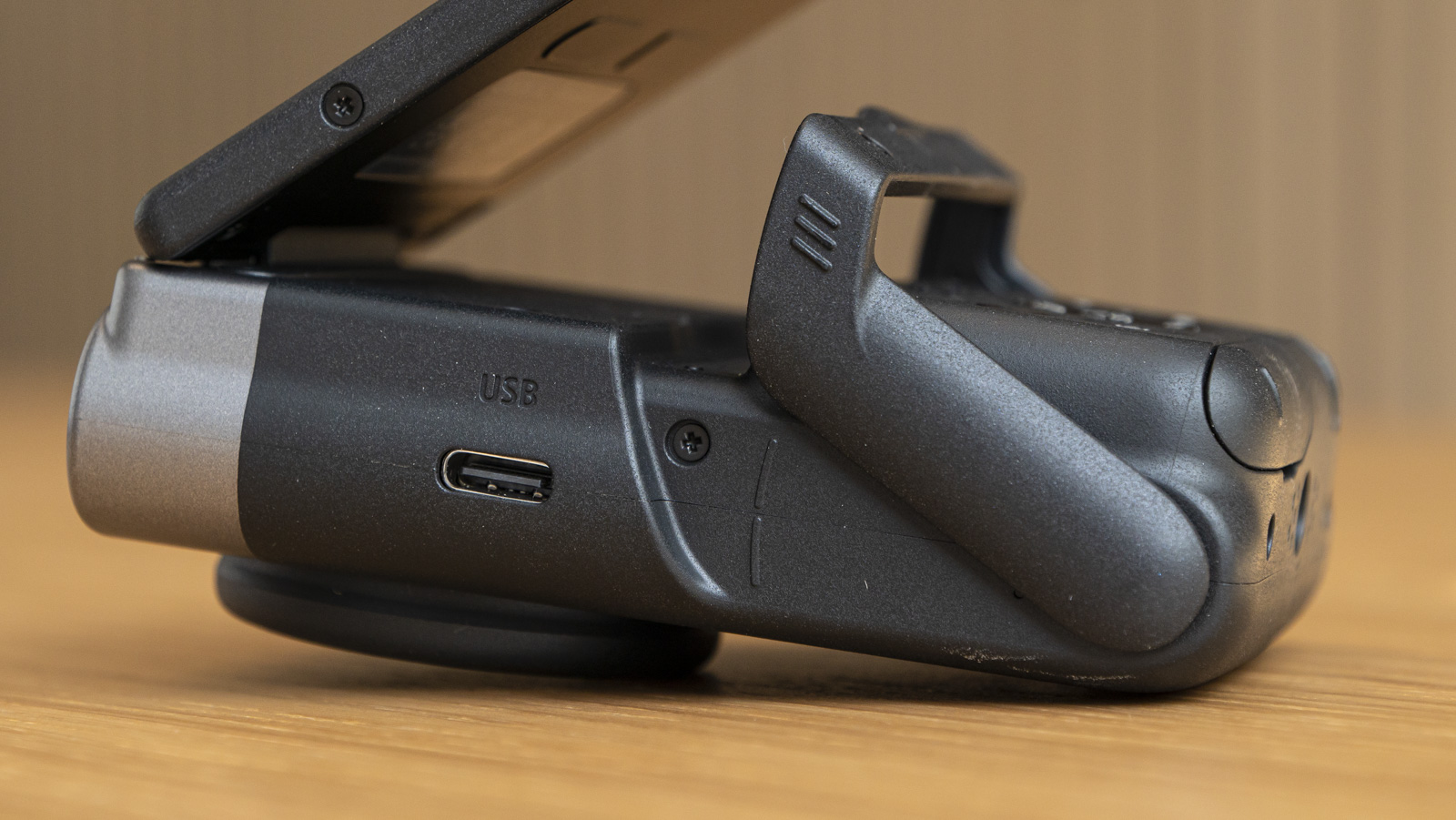



The front of the camera is dominated by a chunky record button and bulbous 6.6mm f/2.8 lens, which Canon says becomes 19mm for photography and 18mm for stills. You can’t zoom in or out, but a fixed ultra-wide lens is what you need for vlogging; if you want to get closer, the camera itself needs to move.
A press of the touchscreen reveals four video recording modes: regular movie shooting, Skin Smoothing, (digital) Image Stabilization video and manual exposure video. These modes cover all bases, and the ultra-wide lens makes all the more sense for run-and-gun videos given that digital image stabilization narrows the field of view a little bit (there are no official numbers on the severity, but it’s minor). That wide-angle lens also means you’re restricted with what you can capture as you can’t zoom into something far away and unaccessible.
There’s also a direct button to switch to photography mode. Ultimately, most shooting scenarios have quick access and there’s little need to delve into the menus. If you do decide to explore the menu further, it’s pleasantly stripped back from Canon’s already rather user-friendly system, with very little to navigate.

Audio-wise, there are omnidirectional stereo microphones on the top of the camera, but there’s no option to isolate sound from any particular direction, unlike on a camera like the Panasonic G100, which can single out front or rear audio, and even use face detection to automatically select the best audio setup. No, the tech in the V10 is much simpler.
Most people who want to improve the quality of audio on a camera like the V10 via its 3.5mm mic input would go down the lavalier mic route. While it’s far from ideal, it’s possible to clip a lavalier mic remote transmitter to the flip-up screen, or customers in Europe can fix the optional cage to the camera, which features a couple of tripod threads that could, in turn, hold such accessories.
An auto wind filter is present, but on windy days the optional windshield accessory will improve audio quality more. Sadly, the design of the camera has not been fully thought through to take account of such accessories – the windshields block at least half of the flip-up screen in selfie mode.
With foresight, perhaps the flip-up screen could also be designed in such a way that it could be pulled up to a more elevated position from the body when in selfie mode. Windshields or not, I’d like to see that kind of design for easier viewing.
Windshields are not the only optional accessories that are poorly implemented. The cage (which has a mediocre build quality, especially the lock), blocks the grip of the fold-out stand, making it difficult to use the stand.
The V10 does have an action camera look and feel about it, but don’t go jumping into the water with it – there’s no weather sealing. That said, for shoots where the camera could get splashed or dirty, I would prefer to risk spoiling the V10 than my smartphone.
After only a brief time using the V10, it’s clear that the lens attracts dirt and smudges, and I found myself cleaning it several times on a single walkabout. I’d recommend tucking a lens cloth into your pocket along with the camera to give the lens a quick clean before recording each time. Moreover, the matte finish of the body is also prone to scuff marks that aren’t easy to rub off.
These niggles aside, the V10 design makes content creation life as easy as possible. It’s refreshingly different, and purpose-built for the job.
• Design score: 4/5
Canon Powershot V10: features and performance
- Same 1-inch sensor as Powershot G7 X III
- Non-removable battery with up to 1 hour of battery life
- Digital image stabilization only
- No heat management
As mentioned earlier, inside the Powershot V10 is the same 1-inch sensor that’s in the Canon Powershot G7 X III, although that camera features a zoom lens, and the sensor here has been optimized for the ultra-wide lens.
If you’re not familiar with the G7 X III, it was a compelling option for vlogging when it was launched – but that was four years ago, and we’re getting essentially the same tech in the V10, at a time when smartphone cameras have rapidly advanced.
Stills-wise, the sensor has 20MP and can shoot in JPEG format only. And considering it's a fixed lens, you're limited to wide-angle shots – 18mm for stills and 19mm equivalent for movies.
The V10 is geared for video content though, and to that end offers 4K video up to 30fps (and up to ISO 3200) and full HD video up to 60fps (and up to ISO 6400). In 2023, those recording options are the bare minimum we would expect, so color me a little disappointed.
Files are stored on a microSD card – a storage typically used by older and more basic cameras and phones. That said, I can see why Canon would opt for a microSD card here as there's hardly any space to fit a full-sized SD card. If you're trying to shoot the highest-quality 4K video, your record times will be hamstrung unless you insert the highest-performing microSD card available – and this warning shows up on screen every single time you enter the video shooting mode.

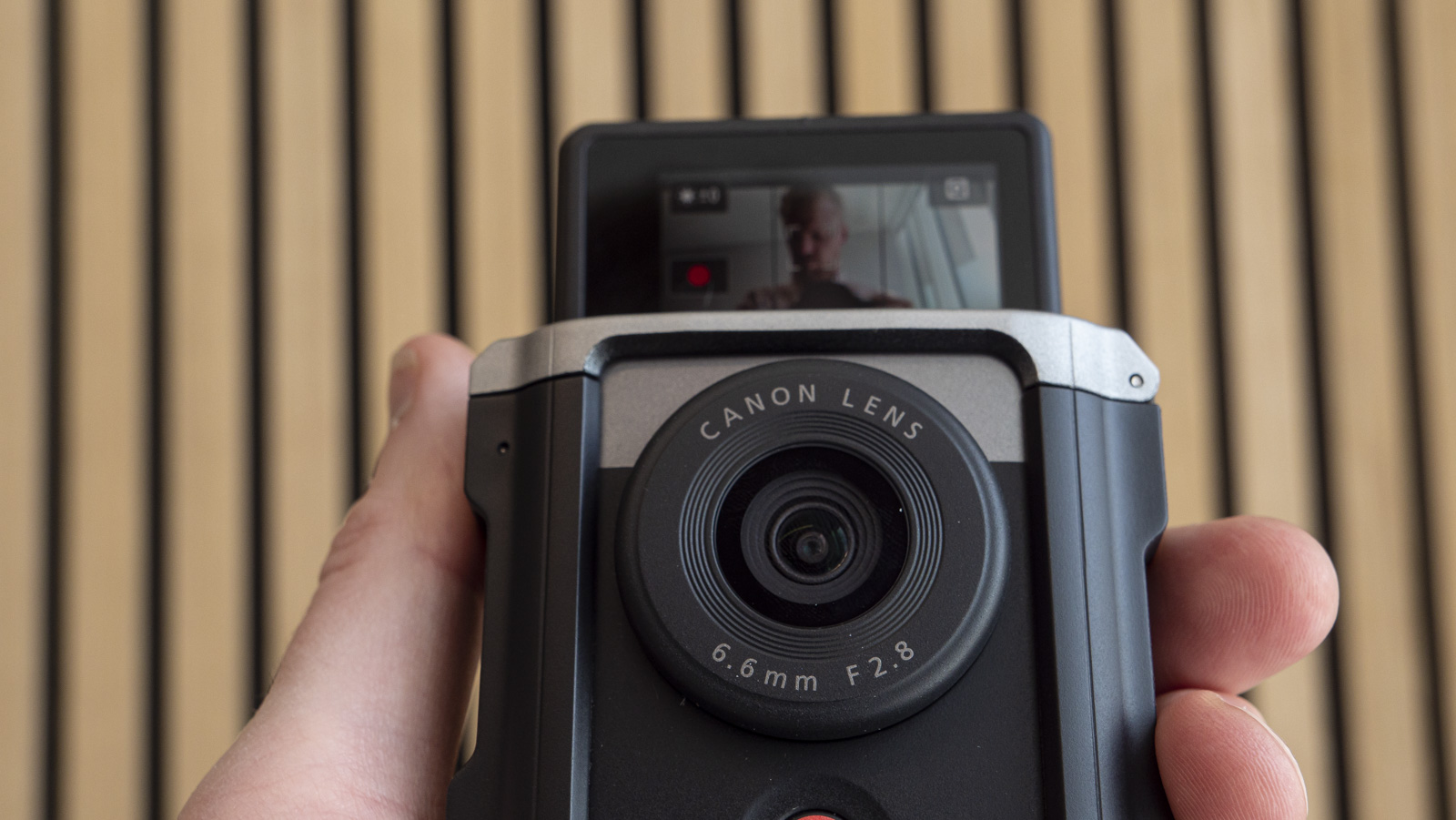





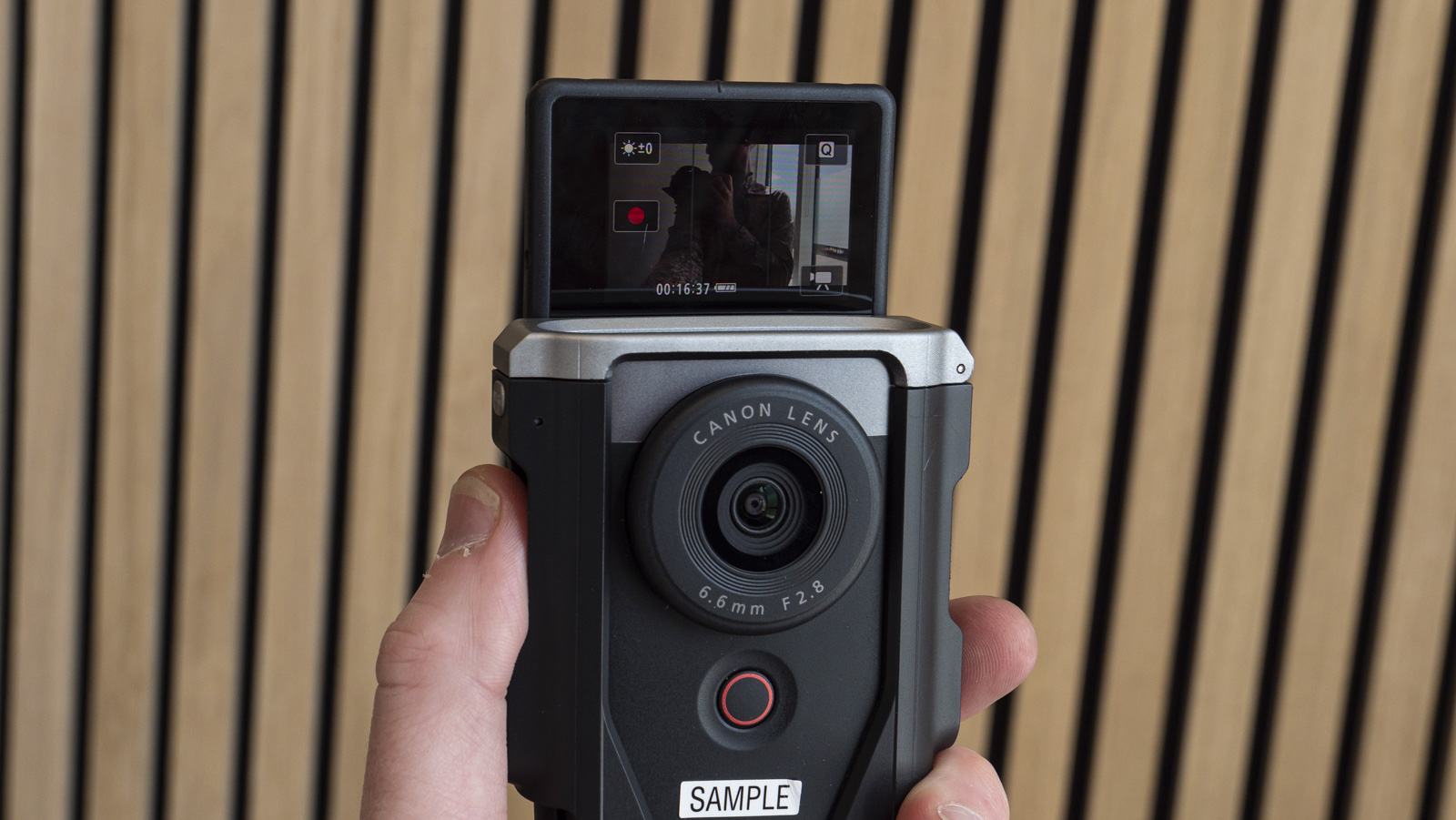
The issue of space is also evident in the connectivity choices too. There’s a USB-C (2.0 speed) port to handle in-camera battery charging and data transfer, as well as for plug-and-play webcam duties if you’re live streaming or using it for video calls. It’s possible to charge the camera while recording, say via an attached power bank. And instead of a full-sized HDMI port is a micro HDMI one.
Wireless connectivity is an option here, but it’s Bluetooth 4.2 (the latest standard is 5.4) and single-band 2.4GHz Wi-Fi. Dated as that might seem, the Powershot V10 offers a relatively headache-free wireless streaming experience via the Canon Camera Connect app. Setup takes a few minutes – you’ll need to select the right camera option in order to get all the options available to the V10 – and then you’re ready to connect to Facebook, YouTube and other platforms in Full HD, with 6Mps and 3.5Mbps options.
For those on the move with the V10, there’s digital image stabilization. It’s less effective than in-body image stabilization and, as already mentioned, imposes a small crop of the image area. From a look at handheld walking videos shot with the V10, its digital IS is a little jittery, but certainly smoothes out some of the vibrations caused by footsteps.
Canon’s face and subject-tracking AF is implemented, and for the simple situations in which I’ve used the camera to capture people, like selfie shooting, it’s proven to be sticky and reliable.

Canon doesn’t disclose the capacity of the battery used in its Powershot V10, but it’s got a CIPA rating of 290 still shots or up to 55 minutes of 4K recording. That seems underwhelming, but then there’s only so much Canon can pack into the small body of the camera.
I couldn’t put that 55-minute claim to the test as the camera shut down at the 21-minute mark during my video testing due to overheating. And that can be a major problem here if you’re not used to dealing with it on your phone. The camera warns you of this even before you begin recording, so you will need to keep an eye on the on-screen heat gauge to avoid getting cut off abruptly.
Incidentally, I got 21 minutes of shooting while the camera was left on its stand – the heat buildup is a touch quicker when shooting handheld.
• Features and performance score: 3/5
Canon Powershot V10: image and video quality
- JPEG-only 20MP stills
- Sharp ultra-wide lens
- Canon’s accurate color science
A 1-inch sensor is larger than the majority of sensors found in today’s smartphones, and so the V10 has a natural advantage when it comes to image and video quality, especially as the camera also benefits from the same color science as Canon’s EOS R mirrorless cameras. But does that translate to real-world use?
You can keep settings at auto and pictures will look lovely… under the right circumstances. When the circumstances are just right, the 20MP (5472 x 3648 pixel) images pack a decent amount of detail, and the lens is sharp, with little fall-off in the corners, which is impressive given how wide its field of view is. There is some barrel distortion, which is to be expected with an ultra-wide lens, but it’s nothing distracting, and is minimized by automatic JPEG processing.
There’s no option to shoot in raw format – which is a format that allows for more extensive exposure corrections than compressed JPEG files. There’s also no HEIF format support here (which Canon’s newer EOS R-series cameras offer), so there’s really little room for post-shoot adjustments for stills.






For instance, auto errs on the side of overexposure, and there can be some clipping in bright highlights like white clouds, which is hard to recover. That said, you will likely get a decent amount of good shots when lighting is just right, but you can also get the same results from some of the best camera phones. Unlike a phone, though, there are 14 color filters that can be applied to photos and videos should you wish to get creative.
Video-wise, the aspect ratio can be set to 16:9 or 9:16, and skin smoothing can be applied in varying degrees of strength depending just how vain (or self-conscious) you are. There’s also a built-in ND filter that can regulate exposure when moving between bright and dark environments, but it’s not always effective and I saw some overexposed sections in some clips I captured during a sunny day.
Despite manual exposure being available, this is a camera that’s best left to create at the click of a button, with minimal fiddling around with settings. However, in bright conditions, we found the auto movie mode to overexpose frames. The IS Movie mode adds digital stabilization automatically and works quite well for the most part, but there are occasions of some shaking when walking fast with the camera.
Low-light performance of the V10 isn’t anything to write home about either. It’s… fine, like your smartphone for the most part and this is for both stills and video. Despite a top ISO sensitivity of 12,800 for stills, noise performance isn’t great, with a lot of my nighttime captures showing a little grain. That said, stills and videos taken in low light are fine for sharing on social media, you just won’t want to enlarge your stills.
I was quite impressed by how well the camera picked up sound – footsteps crunching on coarse sand is clearly heard in a clip when I was annoying some seagulls. You will, however, need a wind filter if you’re outside in windy conditions, as you can tell from the nighttime clip where I was recording aboard a Sydney ferry. I’ve left all the original sounds picked up by the camera in my sample montage so you can judge sound pick-up for yourself.
• Image quality score: 3.5/5
Should I buy the Canon Powershot V10?
| Attribute | Notes | Score |
|---|---|---|
| Value: | While not as expensive as a flagship smartphone, it’s possible to get a traditional and more capable vlogging camera at a similar price point. | 3/5 |
| Design: | A very interesting design that might be its lucky charm. | 4/5 |
| Features & performance: | Some dated tech here diminishes its appeal, as does its battery life, although it hits the nail on the head as an easy-to-use camera. | 3/5 |
| Image quality: | Canon’s color science does not disappoint here, although digital stabilization isn’t always ideal. | 4/5 |
Buy it if...
You want an unconventional camera
There’s no denying that the Powershot V10 has an interesting design. It’s tiny, oh-so-pocketable and its nifty stand is handy to have.
You want a simple, easy-to-use vlogging camera
The Powershot V10 nails the concept of ‘point and shoot’. It’s aimed at users who are intimidated by camera tech and simplifies the process by stripping back a lot of features. And for that, it’s well priced.
Don't buy it if...
You want to shoot HDR video
If you’re after some better dynamic range for shooting in specific scenarios, you’re out of luck here.
You want more control over the results
Despite a manual exposure movie mode, there’s not a whole lot of control over what the results will look like with the V10. If you are looking to control every aspect of the shoot, you definitely want a camera with more controls.
You want to record nonstop for 20 minutes and over
The overheating on the V10 can significantly limit recording times, so if you think you’ll need to capture video for over 20 minutes, you might want to consider a proper vlogging camera with better heat management.
Also consider
Sony ZV-1F
It may not be as small as the V10, but this Sony compact makes taking videos quite simple, too. It boasts Sony’s SteadyShot stabilization tech that’s better than the V10’s digital IS, plus great autofocus and tracking abilities. There’s even a dedicated Product Showcase mode that enhances bokeh (blurry background) for product shots. It’s great for beginner vloggers.
Read our in-depth Sony ZV-1F review for more details
GoPro Hero11 Black
If size is an important factor, then consider the GoPro Hero 11 Black if you want a more versatile camera. It’s one of the best action cameras on the market, but it’s just as good for vlogging, too; 27MP on tap, a versatile set of aspect ratios for vertical video capture and a clean user interface.
Read our hands-on GoPro Hero11 Black review
DJI Pocket 2
If a tiny screen doesn’t bother you, the DJI Pocket 2 is cheaper than the V10. You get 4K video at up to 60fps here. This handheld option is great for those who do most of their video capture while on the move. Footage is stable thanks to a three-axis gimbal, plus you get a very capable subject tracking system on board too.
Find out more in our DJI Pocket 2 review
How I tested the Canon Powershot V10

Considering the Powershot V10’s pocketable size, I took it on some of my daily walks, which were typically in daylight. I did, however, spend a few hours walking around Sydney’s city center during the annual festival of lights called Vivid Sydney, to try and capture low-light footage. To put the camera to the ultimate test, I used it in IS mode to film some lights while bouncing around on a ferry. I also took similar stills and videos on my iPhone 13 Pro to compare.
To test how well the camera can handle heat build-up while shooting 4K footage, I started a recording and left the camera on a table on its stand, letting it shut down on its own. I did the same while holding it as well.
[First reviewed June 2023]

While she's happiest with a camera in her hand, Sharmishta's main priority is being TechRadar's APAC Managing Editor, looking after the day-to-day functioning of the Australian, New Zealand and Singapore editions of the site, steering everything from news and reviews to ecommerce content like deals and coupon codes. While she loves reviewing cameras and lenses when she can, she's also an avid reader and has become quite the expert on ereaders and E Ink writing tablets, having appeared on Singaporean radio to talk about these underrated devices. Other than her duties at TechRadar, she's also the Managing Editor of the Australian edition of Digital Camera World, and writes for Tom's Guide and T3.
- Timothy ColemanCameras editor



